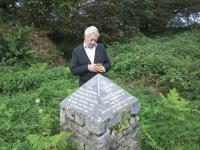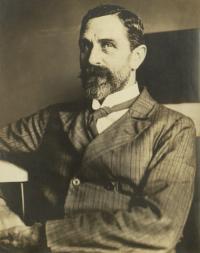A noble life for a Nobel Laureate
Published in 20th-century / Contemporary History, Issue 2(March/April 2012), News, Revolutionary Period 1912-23, Volume 20
Mario Vargas Llosa in 2009 at McKenna’s Fort, near Banna Strand, Co. Kerry, where Sir Roger Casement was arrested on 21 April 1916. (Angus Mitchell, Villanova University Digital Library)
Packed with historical detail, El sueño del celta/The dream of the Celt takes place in a windowless cell in Pentonville Prison during the summer of 1916, as Casement reflects on his life in the weeks before his execution. Interspersed with these musings of a condemned man are chapters relating to his youth, his years in Africa and Brazil, investigations into crimes against humanity, and his eighteen months in Germany. Such was the hype surrounding the release of the original book that an unprecedented print-run of 500,000 copies were distributed across the Spanish-speaking world, and within 48 hours pirated editions were available on street corners in Mexico City and downtown Lima.Vargas Llosa’s attraction to Casement stems from a long preoccupation with questions to do with messianic movements, the confrontation between revolutionary nationalism and colonial power, and the relationship between fact and fiction. ‘He seems to be a character whose natural environment is a very great novel, not the real world’, commented Vargas Llosa, in an interview shortly before publication of the book. Casement’s life is intriguingly intertwined with three seminal novels of the early twentieth century: Joseph Conrad’s Heart of darkness, Erskine Childers’s The riddle of the sands and Arthur Conan Doyle’s The lost world.On the enduring question of the authenticity of the Black diaries, Vargas Llosa remained deliberately ambiguous. The cover of his book referred to the ‘doubtful veracity’ of the disputed documents, but this did not deter the author from engaging brazenly with his hero’s sex life—carnal passion is a central theme of all his fiction. Vargas Llosa defended his use of the diaries based on artistic or narrative licence and his proposal of the requirement to manipulate truth for political expediency—a position articulated in his essay ‘The truth of lies’. His genius as a storyteller is to redirect history to his own imaginative ends. This is achieved in his two acclaimed historical novels: The war of the end of the world, a retelling of the overthrow of the Brazilian mystic Antonio Conselheiro, and The feast of the goat, describing the collapsing dictatorship of the Dominican Republic’s Rafael Trujillo. On awarding the prize, the Swedish Academy singled out Vargas Llosa ‘for his cartography of power and trenchant images of the individual’s resistance, revolt and defeat’. The comment applies perfectly to Casement’s tragic trajectory.

Sir Roger Casement
The noise surrounding Vargas Llosa’s intervention inspired further developments in the interpretation of Ireland’s most exportable and enigmatic rebel. In the spring of 2011 two different versions of The Amazon journal of Roger Casement (for an abstract of my introduction see HI 5.3, Autumn 1997, pp 36–41) were published in Spanish: a popular and concise translation, Diario del Amazonas, by Cristina Oñoro and Stella Ramos, and a more comprehensive edition, Diario de la Amazonía, translated by Sonia Fernández Ordás. The latter work is supplemented with an album of Amazon photographs taken by Casement and discovered by the historian Jordan Goodman during research for his book The Devil and Mr Casement (2008).The cumulative effect of this has placed Roger Casement firmly on the research agenda of universities across South America. A travelling exhibition, ‘Roger Casement in Brazil: Rubber, the Amazon and the Atlantic World 1884–1916’, was launched in 2010 at the Federal University of the Amazon in Manaus, before relocating to the University of São Paulo in May 2011. The exhibition is at present in Buenos Aires and there are plans to take it to Spain in the autumn and to New York and possibly Ireland after that. Colombia also marked the centenary of his Amazon investigation with a four-day conference at the National University in Bogotá.More is afoot. During the Roger Casement August Gathering in Tralee in August 2011, Helen O’Carroll of the Kerry County Museum announced her intention to hold an exhibition on the local ramifications of Casement’s landing at Banna Strand on Good Friday 1916. Various film projects are also in early stages of pre-production. Over the next four years, Casement looks set to emerge as the ‘known unknown’ of the Easter Rising. Just over a century ago, in the autumn of 1911, Casement made his second journey up the Amazon: the most dangerous and covert voyage of his consular career. His hidden agenda was to prepare British trading interests in the region for the collapse of the extractive rubber market and to incite regime change in Iquitos. With regard to the second objective, history would repeat itself when he returned to Ireland on board a submarine in April 1916 intent on the overthrow of the British Empire. HI
Angus Mitchell is currently writing a critical biography of Alice Stopford Green.
















